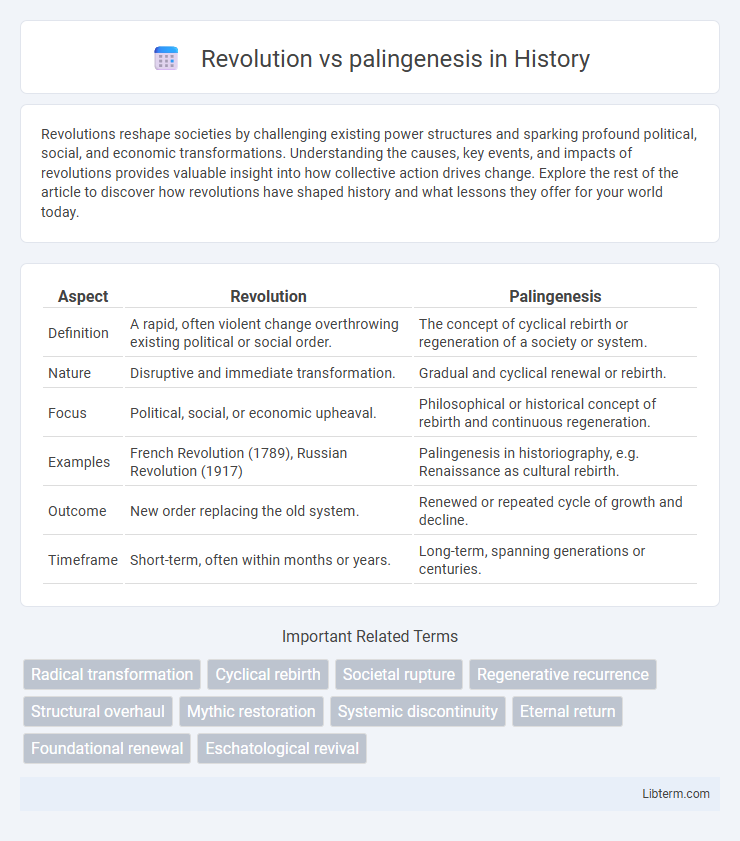Revolutions reshape societies by challenging existing power structures and sparking profound political, social, and economic transformations. Understanding the causes, key events, and impacts of revolutions provides valuable insight into how collective action drives change. Explore the rest of the article to discover how revolutions have shaped history and what lessons they offer for your world today.
Table of Comparison
| Aspect | Revolution | Palingenesis |
|---|---|---|
| Definition | A rapid, often violent change overthrowing existing political or social order. | The concept of cyclical rebirth or regeneration of a society or system. |
| Nature | Disruptive and immediate transformation. | Gradual and cyclical renewal or rebirth. |
| Focus | Political, social, or economic upheaval. | Philosophical or historical concept of rebirth and continuous regeneration. |
| Examples | French Revolution (1789), Russian Revolution (1917) | Palingenesis in historiography, e.g. Renaissance as cultural rebirth. |
| Outcome | New order replacing the old system. | Renewed or repeated cycle of growth and decline. |
| Timeframe | Short-term, often within months or years. | Long-term, spanning generations or centuries. |
Defining Revolution: Concepts and Contexts
Revolution refers to a radical, sudden transformation in political, social, or economic structures, often driven by collective action and aiming to overthrow existing power systems. It is characterized by abrupt change rooted in conflict, frequently reshaping governance, societal norms, and institutional frameworks. In contrast, palingenesis signifies cyclical or regenerative rebirth, emphasizing renewal rather than abrupt overthrow, making revolution a distinct concept marked by disruption and reconstitution of established orders.
The Meaning of Palingenesis in Political Thought
Palingenesis in political thought refers to the concept of rebirth or regeneration of a political body, often implying a complete renewal of society through a transformative process rather than abrupt upheaval. Unlike revolution, which denotes sudden, often violent change, palingenesis emphasizes cyclical rejuvenation and the restoration of an idealized order. This notion has been central to various ideological frameworks, including fascist movements, where the idea of national rebirth underpins the political narrative of restoring former glory.
Historical Examples of Revolution
The French Revolution of 1789 exemplifies a political upheaval characterized by rapid, radical change, overthrowing the monarchy and establishing a republic through popular uprising and violence. Similarly, the Russian Revolution of 1917 dismantled the centuries-old Tsarist autocracy, leading to the rise of the Soviet Union and profound societal transformation. These revolutions contrast with palingenesis, which refers to cyclical rebirth or renewal rather than abrupt systemic collapse and reconstruction.
Palingenesis and the Idea of National Rebirth
Palingenesis refers to the idea of national rebirth, emphasizing the revival of a nation's identity, culture, and values after a period of decline or crisis. This concept often manifests through symbolic rituals, myths of origin, and cultural renaissance aimed at reconstructing collective consciousness and social unity. Unlike revolution, which implies rapid, often violent political change, palingenesis embodies a more spiritual and cultural regeneration, fostering long-term national cohesion and renewal.
Key Differences Between Revolution and Palingenesis
Revolution involves rapid, often violent, and fundamental political or social change, while palingenesis refers to the concept of rebirth or renewal, frequently in a cultural or spiritual context. Revolutions typically disrupt existing power structures and institutions, whereas palingenesis emphasizes cyclic regeneration or a return to an idealized original state. Key differences also include the temporal nature, with revolution being abrupt and palingenesis being a continual, evolutionary process.
The Role of Ideology in Revolution vs Palingenesis
The role of ideology in revolution centers on the overthrow and replacement of existing social and political structures, emphasizing immediate change driven by conflict and power struggles. In contrast, palingenesis involves the ideological belief in a cyclical rebirth or renewal of society, often guided by a narrative of moral or cultural purification and regeneration. While revolutionary ideology focuses on abrupt transformation, palingenesis promotes a vision of continuous rebirth grounded in restoring idealized past values or creating a fundamentally new order.
Revolution as Social Upheaval
Revolution as social upheaval signifies a rapid and often violent transformation of political, economic, and social structures, disrupting established power hierarchies and sparking widespread participation among marginalized groups. Unlike palingenesis, which implies a cyclic and regenerative rebirth of society with an emphasis on ideological or spiritual renewal, revolution foregrounds immediate, material changes driven by social conflict and class struggle. Historical examples such as the French and Russian Revolutions demonstrate the profound impact of social upheavals in dismantling old regimes and ushering in radical systemic shifts.
Palingenesis in Modern Political Movements
Palingenesis in modern political movements refers to the concept of societal rebirth or regeneration following a period of decay or crisis, often invoked to justify radical transformation. This idea emphasizes a cyclical view of history where a new, ideal state emerges from the destruction of the old order. Political ideologies such as fascism and certain nationalist movements have utilized palingenesis to legitimize their agendas by promising a rebirth of national strength and purity.
Impacts on Society: Transformation versus Renewal
Revolution triggers rapid, often disruptive societal transformation marked by abrupt political, economic, and cultural upheavals that fundamentally alter existing structures and power dynamics. Palingenesis emphasizes gradual renewal, fostering a rebirth of core values and institutions while preserving historical continuity and social cohesion. The societal impact of revolution tends toward fragmentation and conflict, whereas palingenesis promotes stability through evolutionary change and ideological revitalization.
Revolution and Palingenesis: Risks and Outcomes
Revolution entails rapid, often violent social or political upheaval with risks including instability, loss of life, and economic collapse, while its outcomes can lead to significant systemic change or prolonged conflict. Palingenesis, referring to rebirth or renewal within societies or ideologies, carries risks of rigid dogmatism and resistance to gradual reform but often results in cultural or spiritual revitalization. Both processes influence societal evolution, with revolution accelerating transformation through disruption and palingenesis fostering renewal through continuity.
Revolution Infographic

 libterm.com
libterm.com